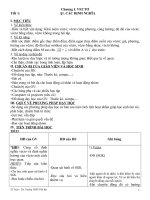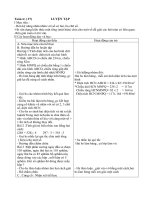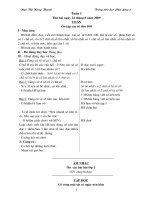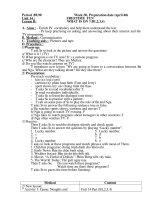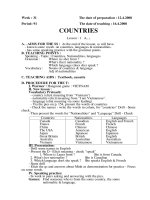GIAO AN UNIT5
Bạn đang xem bản rút gọn của tài liệu. Xem và tải ngay bản đầy đủ của tài liệu tại đây (430.13 KB, 12 trang )
<span class='text_page_counter'>(1)</span>1. Objectives: By the end of the lesson, Ss’ll be able to understand the importance and application of computer. 2. Materials: Textbooks, posters, handouts 3. Procedure Time. 5’. 15’. 7’. Contents I. WARMER Matching Do the task in Before You Read on page 54 Keys: 1. D 2. E 3. G 4. C 5. A 6. F 7. B 8. H II. PRE-READING 1. Pre-teach Vocabulary 1. miraculous (adj) = wonderful: tuyệt vời (synonym) 2. a calculating machine (n): máy tính (visual) 3. storage device (n): thiết bị lưu giữ thông tin (situation) 4. (to) communicate: giao tiếp (situation) => communicator (n): thiết bị giao tiếp 5. request for leave (n): xin nghi phép (trans.) 6. capable of V-ing (adj): có khả năng làm gì đó 2. Pre-question Pair work What do people use computer for? To store documents, to chat… III. WHILE-READING Set the scene: you are going to read about the uses of computer and do the tasks followed. TASK 1 Pair work The words in A appear in the reading passage. Match them with their definition in B. A B 1. magical a. link or act on each other 2. places of b. programmes performed by the scenic beauty computer 3. interact c. in a strange or mysterious way 4. software d. the physical part of the 5. hardware computer system e. places where the scenes are interesting and beautiful Keys: 1c 2e 3a 4b 5d. Teacher and Ss’ activities _ run through all computer parts. _ get Ss to work in pairs to do matching. _ give feedback.. _ elicit new vocabulary. _ model 2 times. _ choral repetition. _ individual repetition. _ check pronunciation. _ check stress, meaning.. Aim Get sts ready to learn the new lesson. Give sts vocab and useful language to read the passage Want sts to understand the passage. _ raise the question to the Ss. _ get Ss to answer in pairs. _ give feedback. _ set the scene. _ get Ss to do the matching in pairs. _ give feedback.. Let sts go deeply the reading text.
<span class='text_page_counter'>(2)</span> 3’. 10’. 5’. TASK 2 individual work Decide which of the three options below is the best title for the passage. A. The Computer – A New Invention B. The Computer Has Become Part of Our Life C. What Can the Computer Do? Keys: C. What can the computer can do? TASK 3 pair work Answer these questions, using the cues below. 1. What can a computer do to help us in our daily life? Visit, pay, read, receive, send, learn 2. Why is a computer a miraculous device? Capable of, a calculating machine, an electronic store, a magical typewriter, a personal communicator, for entertainment Keys: 1. It helps us visit shops, offices and places of interests, pay bills, read newspapers, receive and send letters, and learn foreign language. 2. Because it is capable of doing anything you ask; it can speed up the calculations, allow you to type and print any kind of document, help you to interact with people around the world. It also helps you entertain such as playing computer games and listening to computer-played music. IV. POST-READING Discussion Pair work Answer the questions 1. Do you usually use computer? What do you use computer for? 2. What uses of computer do you like best? Why? V. Homework: Write a short P about the question 2.. _ get Ss to choose the best title for the passage in individually. _ give feedback.. _ explain the exercise for the Ss. _ get Ss to work in pairs. _ Ss write their answers on subordinate boards. _ give feedback.. _ raise the two questions to Ss. _ Ss discuss the questions in pairs. _ give feedback..
<span class='text_page_counter'>(3)</span> 1. Objectives: By the end of the lesson, Ss’ll be able to ask and answer about the functions of modern devices and the importance of information technology in daily life. 2. Materials: Textbooks, posters, handouts 3. Procedure Time. 5’. 5’. Contents I. ORAL TEST a. Check the meaning, stress & pronunciation of the following words “miraculous”, “calculating machine”, “request for leave”, “communicator”. b. - What are the uses of computer? - Why is computer a miraculous device? II. PRE-SPEAKING 1. Pre-teach Vocabulary 1. (to) transmit: chuyển giao, dẫn qua (mime) 2. (to) process: xử lý, chế biến (translation) 3. (to) store: dự trữ, tích trữ (situation) “ what do computers do with our documents?” 4. (to) design: thiết kế (translation) 2. Pre-activity Set the scene: you are going to practice talking about the uses of modern devices. TASK 1: Pair work Ask and answer questions about the uses of modern inventions. Useful speaking structures:. 10’. Be used to + Ving (quen thuộc với …..) Be used for + Ving ( dùng để làm gì .. ) Radio languages) TV Fax machine Electric cooker. listen (news / music), learn (foreign watch (news / performances / football Matches), learn (foreign languages) send / receive (letter / picture) quickly cook (rice / meat / fish / vegetables), keep (food / rice / warm) keep (air cool or warm / when it / hot or. Air conditioner cold) Ex: - Can / could you tell me what the radio is used for? (Well, it’s used to listen to the news and learn foreign languages.) - Can you tell me what the TV is used for? (Well, it’s used to watch football matches. and TV game shows.) - Can you tell me what the fax machine is used for? (Well, it’s. Teacher & Ss’ activities _ call any student to check the old lesson. _ give feedback and marks.. Purpose Get sts ready to learn the new lesson. _ elicit new vocabulary. _ model 2 times. _ choral repetition. _ individual repetition. _ check pronunciation. _ check stress, meaning. _ set the scene. Give sts some expressions in speaking _ raise the task and introduce the useful speaking structures. _ get Ss ask and answer questions about the uses of modern devices. _ call some pairs to give feedback..
<span class='text_page_counter'>(4)</span> 10’. 10’. 5’. used to send and receive letters quickly.) - Can you tell me what the electric cooker is used for? (Well, it’s used to cook rice and keep rice warm.) - Can you tell me what the air conditioner is used for? (Well, it’s used to keep the air cool when it’s hot and vice versa.) III. WHILE-SPEAKING TASK 2 Pair work Complete the sentences below. Use the words in the box. (You will have to use some verbs more than once) transmit receive make process store send hold design Information technology is very useful to our lives. It allows us to: 1. _________ very large amounts of information, 2. _________ information quickly, 3. _________ information as soon as we receive it With the development of information technology we can now: 4. _________ messages from one computer to another, 5. _________ long distance meetings in which the participants can see each other on a screen, 6. _________ use of central stores of information, 7. _________ TV programmes to other countries, 8. _________ TV programmes from other countries, 9. _________ houses, bridges, gardens and buildings. Keys: 1. store 2. transmit 3. process 4. send 5. hold 6. make 7. send 8. receive 9. design TASK 3 Pair work Look at the ideas in Task 1 & 2, and then rank them in order of importance. Give reasons. (Task 3 – p.56) A: What is the most useful device to our life? B: I think computer is the most useful to our life A: why do you think so? B: Because it allows us to store very large amounts of information. IV. POST-SPEAKING Discussion Answer the question What is your most favorite invention? Give your opinion. V. HOME WORK Write a paragraph about your favorite device.. _ raise the task & get Ss to do it in pairs. _ monitor to help.. Let sts to practise taking role play. _ raise the speaking task. _ give out the speaking sample. _ get Ss to practice in pairs. _ monitor to help. _ call some pairs practice in front of the class and give feedback.. Make sts to be fluent.
<span class='text_page_counter'>(5)</span> 1. Objectives: By the end of the lesson, Ss’ll be able to know the experience of an old company director about learning how to use a computer. 2. Material: Textbooks, posters, handouts, tapescript 3. Procedure Time Contents Teacher and Ss’ activities 5’ I. ORAL TEST _ call any student to a. Check the meaning, stress & pronunciation of the following check the old lesson. words “design”, “transmit”, “process”, and “store”. _ give feedback and b. – Can / you / tell me / what the TV / used ? marks _ What / the most / useful device / to our life? Can you tell me what the TV is used for? What is the most useful device to our life? II. PRE-LISTENING 1. Pre- teach Vov.: _elicit new vocabulary. - worried (adj) = anxious: lo lắng (synonym) 10’ - shy (adj): ngượng ngùng _ model 2 times. ( situation) _ choral repetition. - (to) refuse: từ chối ( mime) _ individual repetition. - (to) make an excuse = say sorry: xin lỗi (synonym) _ check pronunciation. - a memory: bộ nhớ, trí nhớ ( translation) _ check stress, 2. Pre-activity meaning. How often do you use each f the items below? Put a stick in the right column. Then compare yours answer with a partner. Very often sometimes never _ run through the Radio activity. Cell phone _ get Ss work Camcorder individually and Computer compare with their TV partner. Fax machine _ give feed back. 1. Listen and repeat Worried memory refused excuse VDU ( visual display unit) headache III WHILE-LISTENING Set the scene: you are going to listen to an old company director talking about his experience of learning how to use a computer. Task 1: Listen to an old company director talking about his experience of learning how to use a computer. Decide whether _ model the words twice. the statements are true or false. _ choral repetition. T F 1. The man was worried when his son bought a computer. 10’ 2. The man became worried when his. Purp. Get sts re to learn t new less. Give sts and usef language listen the. Sts listen.
<span class='text_page_counter'>(6)</span> secretary asked him to buy a computer. 3. The man decided to take some computing lessons. 4. His son did not understand about the computer. 5. The man understood the lessons very well. 6. The man continued to learn how to use a computer after a few lessons. Keys: 1F 2T 3T. 10’. 10’. 4F. 5F. _ set the scene.. exactly t informat. _ run through 6 statements. _ get Ss to listen to the tape and do the task in pairs. _ give feedback.. 6F. Task 2: Listen to the old man’s story again and write in the missing words. He was very helpful. He invited me to sit down in front of the computer (1) ______. I did not know what it was called. When I asked him what it was, he said that it was a VDU. I still did not know what VDU was, but I was too (2) _____ to ask him more. From that moment, my (3) ___ refused to learn because he told me a lot of things that really did not (4) _____ at all. After a few lessons, I began to feel tired. I make an __ (5) __, saying that I was having a headache. I (6) ______ we should leave the lesson for another day. Since then I have not said about the computer to my son and my secretary. Keys : 1. screen 2. shy 3. memory 4. understand 5. excuse 6. suggested IV. POST-LISTENING Ask and answer about the man’s story: 1. Did the man know how to use the computer? 2. Why did he become worried? 3. What did he do? 4. How did he feel after a few computing lessons? 5. Has he said anything about the computer to his son and secretary? V. HOME WORK Review the lesson and prepare the writing lesson.. Make sts listen to detail the informat. _ get Ss to work in pairs to listen and fill in the blanks. _ give feedback.. _ get Ss answers the questions in pairs. _ Ss read out their answers. _ give feedback..
<span class='text_page_counter'>(7)</span> Time 5’. 5’. 5’. 5’. 1. Objectives: By the end of the lesson, Ss’ll be able to know how to use public telephones and write a set of instructions on how to operate a T.V with a remote control . 2. Materials: Textbooks, posters, handouts 3. Procedure: Contents Teacher & Ss’ activities Purpose I. Oral Test _ call any student to check a. - Write the form, the uses, and adverbs of time of present the old lesson. perfect. _ give feedback and marks. - They (arrive) there since yesterday? What use of present perfect is the sentence above? b. Tell / you / me/ could/ what/ is / a computer / for / used? II. Pre-Writing 1. Pre-Teach 1. (to) lift: nhấc (realia) _elicit new vocabulary. 2. a reciever (n): ống nghe (visual) _ model 2 times. 3. (to) insert: đưa vào (situation) _ choral repetition. 4. (to) press: nhấn (realia) _ individual repetition. 5. (to) dial: bấm số (situation) _ check pronunciation. 6. an ambulance: xe cứu thương _ check stress, meaning. 2. Pre-Activity TASK 1. individual work Read the following set of instructions on how to use a public telephone. _ get Ss to read individually. PLEASE READ THESE INSTRUCTIONS CAREFULLY To make a call you will need a phone card. Make sure you know the number you are calling. TO OPERATE THE TELEPHONE First, lift the receiver, and listen to the dial tone. Next, insert your phone card in the slot. Then press the number you require. Wait until you hear the long pips. This means that your call has been through. EMERGENCIES To call the Police, dial 113. To call the Fire Service, dial 114. To call an ambulance, dial 115. To obtain help, dial 116.. TASK Pairwork Find out the connectors and the imperative form of the verbs from the instructions. Keys: - connectors: first, next, then - Imperative forms of the verbs: lift, insert, press, wait, dial… Writing instructions: Connectors and imperatives are used in instructions.. _ get Ss to work in pairs. _ monitor to help. _ give feedback..
<span class='text_page_counter'>(8)</span> 5’. 15’. 5’. Task 3 Pair work Look at the TV and the remote control below, and answer the following questions: 1. What do you have to make sure of if you want to operate the TV with the remote control? 2. What should you do if you want to turn on or turn off the TV? 3. What should you do if you want to select a programme? 4. What should you do if you want to watch VTV1, VTV2, VTV3, and VTV4? 5. What should you do if you want to adjust the volume? 6. What should you do if you don’t want to hear the sound? Keys: 1. To operate the TV, you have to make sure the cord is plugged in and the main is turned on. 2. To turn on or off the TV, press the power button. 3. To select a program, press the program button up or down. 4. To watch VTV1, press the button number 1… 5. To adjust the volume, press the volume button up or down. 6. If you want to not hear the sound, press the mute button. III. While-Writing Task 4 pair work Write a set of instructions on how to operate a TV with a remote control. Use the picture and the questions above as suggestions, you may begin with. If you want to operate a TV with a remote control, you must make sure that the cord is plugged in and the main is turned on. IV. Post-Writing Ask SS exchange their writing with a friend; pick up some writings give feedback as the whole class. Keys: To operate the TV, you have to make sure the cord is plugged in and the main is turned on. To turn on or off the TV, press the power button. To select a program, press the program button up or down. To watch VTV1, press the button number 1… To adjust the volume, press the volume button up or down. If you want to not hear the sound, press the mute button. V. Homework _ Rewrite your writing into your notebook. _ Prepare the new lesson.. _ get Ss to look at the picture P. 59 and answer the 6 questions in pairs. _ monitor to help. _ give feedback.. _ get Ss to write in pairs. _ monitor to help. _ get Ss to exchange their writings _ pick up some Ss’ writing to give feedback.. _ set homework..
<span class='text_page_counter'>(9)</span> 1. Objectives: By the end of the lesson, SS wil be able to: - distinguish and pronounce the sounds / / and / / correctly. - use the present perfect and present perfect passive appropriately. - use the relative pronouns correctly. 2. Material: handouts, textbooks, BB… 3. Procedure Time. 5’. 5’. Contents I. Oral Test a. Check the meaning, stress & pronunciation of the following words “lift”, “insert”, “receiver”, “press”, “ dial”, “ ambulance” b. _ List some connectors Sentence building _ press / the power button / to / turn / on / or / off / the TV, II. Presentation 1. Pronunciation / υ /: a short sound / u: /: a long sound Listen and repeat Put foot food fruit Pull look school June Full cook tooth afternoon distinguish two sounds / υ/: is back, closed, sounded, short oo good, book, took u put, pull ou could, should o woman /u:/ : is back, closed, rounded, long oo food, pool, cool u music u ( with e ending) June, blue ew chew ou soup, through ui juice eau beautiful Practice these sentences. 1. Could you tell me where you’ve put my book? 2. Your bookshelf is full of books. 3. Look! The boy is looking at your book. 4. Miss June is looking at the Moon. 5. Both your shoes and your boots are dirty. 6. Miss Moon went to school this afternoon. 2. Grammar And Vocabulary. Teacher & Students’ Activities _ call any student to check the old lesson. _ give feedback and marks.. Purpose Get sts ready to learn the new lesson. Give sts the correct way in pronunciation. _ present the two sounds. _ Ss listen and repeat. _ model the six sentences. _ Ss practice in pairs. _ monitor to help Ss. _ help Ss dist6inguish two sounds.. Supply the grammar points for sts.
<span class='text_page_counter'>(10)</span> 10’. a. Present perfect Affirmative: S ( sing) + has + V 3/ed S (pl) + have + V3/ed Negative: S( sing) + has + not + V3/ed S (pl) + have + not + V3/ed Interrogative: Has + S (sing) + V3/ed ? Have + S (pl) + V3/ed ? Ex: She has just got a letter from her friend She has not just got a letter from her friend Has she just got a letter from her friends? Use: To express an action has just happened. Ex: She has just got a letter from her friend. Let sts to apply the theory. To express an action repeated for times in the past. Ex: I have seen “Titanic” three times. To express an action happened in the past and last until the present or the future. They lived here since 1990.. To express an action happened in the past with indefinite time. Ex: I have gone to Ha Noi. Adverbs of time Just, recently, lately, ever, never, already, not…yet, since + a point of time, for + duration, so far= until now, up to now = up to the present b. Present perfect passive People have built a new bridge across the river. If I want to use “a new bridge as a subject, how can I rewrite the sentence so that the meaning stay the same? A new bridge has been built across the river. S + has/ have + PP + O S + has/have + been + PP …. c. Who, Which, That A new bridge which has been built across the river is near my house. Who, that are relative pronounces used to replace nouns indicating human. Which, that are relative pronounces used to replace nouns indicating sth. Ex: The man who/ that standing there is Mr. Pike This is the book which / that I like best.. _ review present perfect: the form, uses and give examples. _ elicit the passive form from the Ss.. _ review relative pronounces who, that, which _ elicit the uses of who, that, which from the Ss.. Let them to master and sharpen the grammar points.
<span class='text_page_counter'>(11)</span> 5’. 10’. III. Practice Exercise 1 Pair work Tan has invited Quang to his house. When Quang comes, he sees that 1. the door is open. 2. the TV is on. 3. the house is dirty. 4. the floor is clean. 5. the lights are on. 6. two bottles of water are laid of the table. Keys: 1. Tan has opened the door. 2. He has turned on the TV. 3. He has tidied the house. 4. He has cleaned the floor. 5. He has turned on the lights. 6. He has laid two bottled of water on the table. Exercise 2 Pair work Build sentences after the model. Ex: new bridge / build / across the river A new bridge has been built across the river. 1. a new hospital for children / build / in our city 2. another man- made satellite / send up / into space 3. more and more trees / cut down / for wood / by farmers 4. thousands of animals / kill in the forest fire 5. about one hundred buildings and houses / destroy / in the earthquake 6. more than 50 films / show in Hanoi since June 7. their hands / wash and dry / on a towel 8. another book / read / by the students 9. some ink / spill / on the carpet 10. she / show / how to do it Keys: 1. A new hospital for children has been built in our city. 2. Another man- made satellite has been sent up into space. 3. More and more trees have been cut down for wood by farmers. 4. Thousands of animals have been killed in the forest fire. 5. About one hundred buildings and houses have been. destroyed in the earthquake. 6. More than 50 films have been shown in Hanoi since June. 7. Their hands have been washed and dried on a towel. 8. Another book has been read by the students.. _ get Ss to do the task in pairs. _ monitor to help. _ give feedback.. _ get Ss to do the task in pairs. _ monitor to help. _ give feedback.. _ get Ss to do the task in pairs. _ monitor to help. _ give feedback..
<span class='text_page_counter'>(12)</span> 5’. 5’. 9. Some ink has been spilt on the carpet. 10. She has been shown how to do it. Exercise 3 Pair work Fill each blank with who, which or that. 1. A lock is an instrument________ tells you the time. 2. A fridge is a machine_______ is used for keeping food fresh. 3. April 1st is the day ______ is called April Fool’s Day in the West. 4. A nurse is a person_______ looks after patients. 5. A teacher is a person________ gives lessons to students. 6. A blind person is the one______ cannot see anything. 7. The man _______ you visited last month is famous scientist. 8. Please think of the word______ comes from a foreign language into Vietnamese. 9. These are pictures_____ my son drew when has was young. 10. Can you help me find the man______ saved the girl? Keys: 1. which 2. which 3. which 4. who 5.who 6. who 7. who 8. which / that 9. which 10. who IV. Production _ Distinguish the present perfect active and passive in the following sentences: 1. They have been driven to the airport. 2. Somebody has robbed the bank near our house. 3. Nobody has invited her to the party. 4. My bedroom has been decorated. V. Homework _ Complete all sentences of exercises that we have not finished yet. _ Prepare the new lesson.. _ Ss show their answers. _ give feedback. _ get Ss to distinguish the present perfect and its passive form.. _ set homework..
<span class='text_page_counter'>(13)</span>

